
Arthur Schnitzler’s 1897 classic La Ronde becomes a seductive chamber musical in Michael John LaChiusa’s Hello, Again, currently being staged by USC’s Musical Theatre Repertory in an all around sensational production which proves that student produced-directed-acted-designed work can give any professional production a run for its money.
Simply to find 12 college-age singers capable of performing LaChiusa’s complex melodies is a feat in and of itself. That each of the 12 should be an ideal fit for his or her part is even more remarkable. That everything should come together so perfectly under Briga Heelan’s confident direction is something to celebrate.
Like La Ronde, Hello, Again begins with a man and a woman, adds a bit of mystery, seduction, humor, and a big helping of sex, then sends one of the pair into the arms of another, who then couples with yet another, and so on and so forth until the La Ronde comes full circle with the last new character paired with the first to have disappeared from the loop. LaChiusa, who wrote book, music, and lyrics, adds a bit of non-chronological time travel to the mix (the first scene is set circa 1900, the second in the 1940s, the third in the 1960s, then back to the 1930s for scene 4, until the tenth and final scene brings us up to the year 2000). The openly gay composer also adds a homotwist to the circle by having the cast made up of 6 men and 4 women. You do the math.
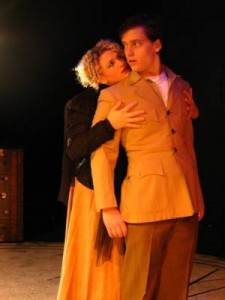
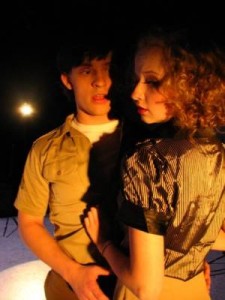
The daisy-chain begins with The Whore (Jessica Perlman) and the Soldier (Peter Byrnes), the latter of whom has no cash to offer in exchange for sex. Fortunately for him, she turns out to be “the one who gives it away” in the first of many simulated sex scenes, more of them than you’re likely ever to have seen in any 90 minutes of musical theater. In fact, of the 10 couplings, only one does not involve copulation, and that’s only because an iceberg gets in the way.
The soldier then meets The Nurse (Mary Kate Wiles), and with a 1940s swing trio providing backup harmony, he sings, “I gotta scratch my itch. May be my last. I got a little war. My boat’s about to leave.” He just wants to get his nuts off. She wants more than just a one night fling. What else is new?
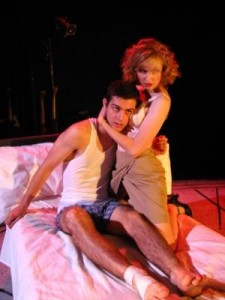
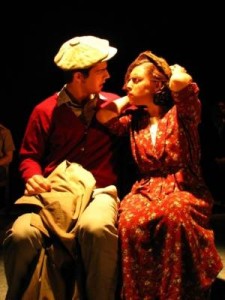
The Vietnam War is raging when the nurse meets The College Boy (Brad Wergley), an Upper East Side rich kid with parents moneyed enough to hire in-home care for the young scion’s sprained angle. Teenage boys may have the reputation for being horny devils, but this time it’s the nurse who takes charge and the college boy learns that stockings have more than one use. (Can you say “Tie me up?”).
Cut to a 1930s movie theater where Fred Astaire is dancing on the screen and the college boy is having an illicit tryst with The Young Wife (Natalie Storrs), who declares herself “morally bankrupt” and proves it by giving college boy a blow job, popcorn sticking to her knees. Now, if only the boy could get it up and keep it up.
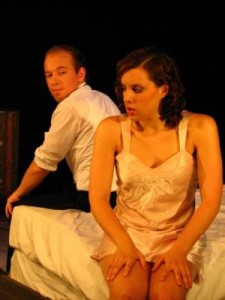

Milton Berle is on the TV (it’s the 1950s after all) as the young wife and The Husband (Steve Edlund) prepare for a night at the opera. But first, a bit of conjugal gratification, during which the young wife fantasizes about love with a stranger in LaChuisa’s catchiest tune, “Tom.” “I can’t remember my husband’s face,” she sings. “I can’t remember my lover’s face. But I can remember a stranger’s face.”
It’s the 1910s and the husband has invited The Young Thing (Michael Peha) to his luxury liner stateroom, telling him “When I saw you board at Southampton I thought: There you were, all alone, sailing across the sea, sweltering in steerage, looking lost and hungry. Fatherless. Penniless. Innocent.” Well not innocent for long if the husband has his way. Then again, there is that pesky iceberg…
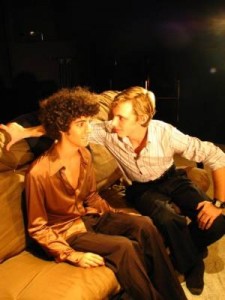
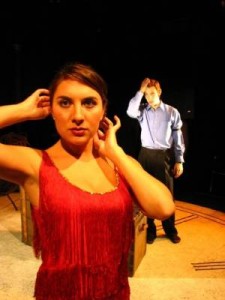
Disco and polyester reign in the 1970s as the young thing meets The Writer (Derik Nelson), who already sees in his mind’s eye the movie De Palma will be making from his screenplay. The young thing wants “somewhere safe, anywhere safe”; the writer wants nothing more than the young thing’s slim young behind, and to paraphrase Lola in Damn Yankees, what writer wants, writer gets, and sweet young thing, horny writer, wants you.
Fortunately for the women of Hello, Again, the writer swings both ways, and is now a 1920s silent movie writer/director/star, appearing opposite The Actress (Emily Goglia) and trying in vain to win a declaration of love from her. (This is Hello, Again’s only scene without a song, though LaChiusa provides silent movie-style musical accompaniment.)
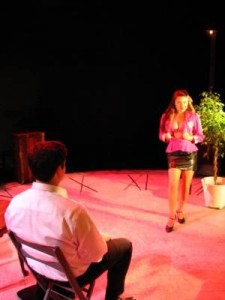
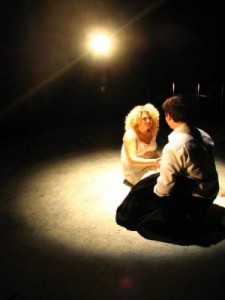
The actress, now living in the 1980s, is mistress to The Senator (Ben Trustman) but desires more from their relationship. “I’ll be what you want, I’ll be anything for you,” she sings, and offers him a diamond brooch she had received from an admirer (to make him jealous?) but to no avail. Soon the senator is out the door and into the arms of …
The Whore, back from Scene 1, in the year 2000, and before she can tell him “Hello, Again,” the circle is complete.
LaChiusa’s often discordant music has been called an acquired taste, the composer’s this-way-and-that-way melodies making Sondheim seem positively Rodgers-and-Hammersteinesque by comparison, however having seen several LaChiusa shows over the past few years, most notably The Blank’s sizzling production of The Wild Party, I must confess to having acquired a taste for his tunes.
Director Heelan clearly knows her LaChiusa and understands Hello, Again to a T, and this shines through in her assured direction. Working with a superb design team on a limited budget, the results are visually quite stunning, and with her entire cast so well chosen and so vocally capable, and Brian P. Kennedy’s musical direction as fine as any I’ve heard in a 99-seat theater, this Hello, Again can’t help but be a winner.
Each of the 10 performers could easily inspire a sentence or even a paragraph of praise. Suffice it to say that there is not a weak link in this cast of first-rate singer/actors, each of whom proves absolutely right for his or her role, from Perlman’s voluptuous whore to Byrnes’ earnest soldier to Wiles’ saucy nurse to Wergley’s eager college boy to Storrs’ frustrated young wife to Edlund’s pervy husband to Peha’s wide-eyed young thing to Nelson’s self-involved writer to Goglia’s diva of an actress to Trustman’s womanizing senator. It also helps that LaChiusa’s characters are, with few exceptions, not too far removed from the actors’ ages, so student production or not, this is simply musical theater at its best.
Notice how LaChiusa’s script allows each cast member to play a number of minor roles, carefully chosen to suit the actors’ main character. The Senator appears as an inebriated man, The Actress doubles as an opera prima donna, and The Young Thing is also a pop singer.
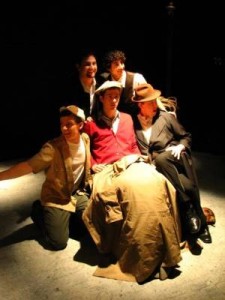

When The College Boy and The Young Wife have their movie theater tryst, they are surrounded by horny men. Scene 2’s 1940s setting features an appropriately swingy trio and quintet,
Scene 7 has most of the cast dancing to a disco beat, and Scene 9 has cast members doubling as 1980s music video performers.
Hello, Again’s music score manages to fit each decade, all the while remaining quintessentially LaChiusa, whether the five-part harmony of the 1940s “We Kiss” or the 1930s tango “Story Of My Life” or the doo-wop 1950s sounds of “At The Prom” or the “do the hustle” beat of the disco-70s “Montage.”
Several dance sequences feature Lili Fuller’s fine choreography. Edlund’s inventive scenic design situates the action atop a large watch face which covers the stage floor, accentuating the notion of traveling through time. Set pieces (a street lamp, a bed, a futon, etc.) complete the minimalist yet very effective set. Natalie Peyser and Edlund’s lighting design is as good as any I’ve seen in a professional small theater production of this kind, colors heightening moods, and a particularly fine final sequence has the actors forming a circle around the stage, each lit from above by a single spot. Costume designer Sarah Morris has met the challenge of creating clothes for the main characters which not only fit era but also personality, as well as numerous costume changes for the many minor characters. Sean Kranz’s sound design insures that the orchestra never overpowers the singers, or vice versa. Musical director Kennedy doesn’t miss a note on the piano, and is backed by an equally fine Kenneth Johnson on bass and Christopher Carhart on percussion.
Next up for Musical Theatre Repertory is an Edlund-directed production of Andrew Lippa’s The Wild Party, which is on my must-see list for January, and should be on yours. In the meantime, Hello, Again, plays at USC through this weekend. See it, or you’ll wish that you had, and who knows when there’ll be another chance to see Hello, Again? With Musical Theatre Repertory doing fine work like this, the future of musical theater is in very good hands indeed.
Massman Theatre, University of Southern California, Los Angeles.
–Steven Stanley
October 2, 2008



 Since 2007, Steven Stanley's StageSceneLA.com has spotlighted the best in Southern California theater via reviews, interviews, and its annual StageSceneLA Scenies.
Since 2007, Steven Stanley's StageSceneLA.com has spotlighted the best in Southern California theater via reviews, interviews, and its annual StageSceneLA Scenies.







 COPYRIGHT 2024 STEVEN STANLEY :: DESIGN BY
COPYRIGHT 2024 STEVEN STANLEY :: DESIGN BY